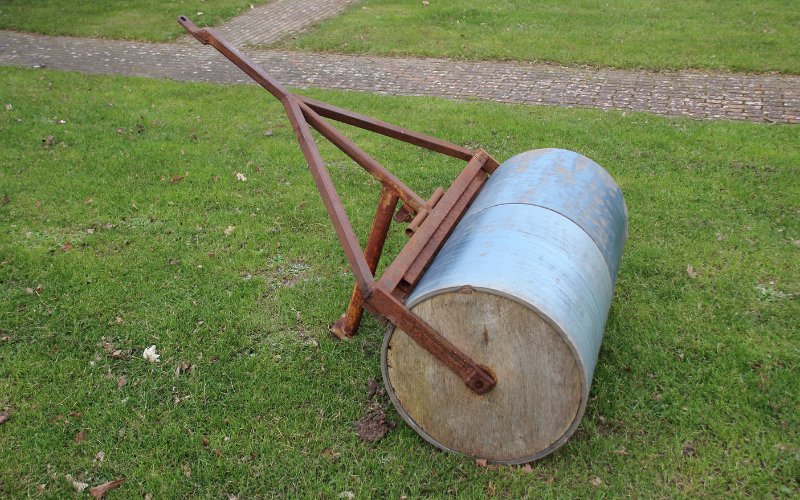There are lots of responsibilities when it comes to having a lush, healthy lawn, such as mowing, fertilizing, pest control, and irrigating, just to name a few. But what about lawn rolling? Are there any benefits of lawn rolling and should you add it to your maintenance routine? Well, if you want a great-looking lawn, rolling might do the trick. Let’s take a look at a few of the reasons you might want to start using a lawn roller.

Main Benefits of Lawn Rolling (The Short Answer)
A lawn roller can be used for several different reasons in a yard. Lawn rolling can help resolve issues caused naturally within the environment and a few that we cause ourselves with landscaping projects. Here are a few reasons why you might need to roll your lawn.
- Flattening the Ground Before Laying Sod
- Flattening Sod After Laying
- Rolling Seeds into the Ground
- Rolling Out Heave & Settling from Freezing
- Flattening Out Heave from Ground Water Expansion
- Flattening Areas Disturbed by Pests & Weeds
Why Roll Your Lawn? (6 Big Benefits)
The main purpose of rolling a lawn is to flatten out any humps and bumps you may have in your yard. I’m definitely not a fan of bouncing around on a riding lawn mower because of bumps in my lawn. So, annual lawn rolling really comes in handy.
Now, I’m not looking to achieve a putting-green finish, but I sure don’t want too many humps. So, Let’s take a look at some of the situations that cause bumps in the first place and how rolling can help.
Flattening the Ground Before Laying Sod
More and more, homeowners are starting to lay sod themselves. This is probably because more box stores sell sod pieces in their landscaping department. Now, laying sod is a multi-stage process that includes preparing the ground. So, a lawn roller is a great way to flatten the ground and remove any unwanted lumps before laying sod.
Flattening Sod After Laying
Another stage in the sod-laying process is to roll the ground once the sod has been installed. If you have laid sod before, then you know the pieces are not all cut to the exact same size and thickness. This can result in a bumpy and lumpy-looking yard.
So, if you want to flatten out your sod once you have finished laying, then a lawn roller is the perfect tool. If you skip rolling new sod, then you’ll have a bumpy lawn forever.
Rolling Seeds into the Ground
Now, for you guys who seed their lawns, then you probably already know that usually, all of the seeds won’t take and germinate. Most of the time, this is because the seeds just sit on the surface without enough contact with the soil. A lawn roller helps push the seeds down into the soil, allowing them to take more quickly and raising the overall success rate.
Rolling Out Heave & Settling from Freezing
If you are in a place like Pennsylvania, Ohio, New York, or any other northern state that gets a pretty good freeze and frost every year, then you’re probably aware of how this affects the ground and causes it to move. This movement is created when the groundwater freezes, expands the soil, and then thaws and settles.
A lawn that looked great during the summer can look terrible come the spring. Homeowners in these northern states are unfortunately used to bumpy lawns. So, if you are one of these people, then a lawn roller is the best solution and certainly the easiest way to solve heave in your yard.
Flattening Out Heave from Ground Water Expansion
Similar to frost heave is water heave. This is where groundwater swells the ground. So, if you are in a low-lying area with a high water table, then you may experience water heave.
Unfortunately, there isn’t much you can do about the causes that create heave, but you can manage the effects. Yep, lawn rolling is the quickest solution to getting your lawn flat once again.
Flattening Areas Disturbed by Pests & Weeds
Deep weed root systems, earthworms, and grubs can all make a mess of your lawn and turn what was a nice flat lawn into a bumpy mess. Now, if you add skunks digging holes for worms and moles making a house under your lawn, then you have a whole army of pests working against you.
A lot of the time, you can deal with most of the pests, but this can take some very hard work, and it’s nearly impossible to be 100% successful. So, a bumpy lawn is inevitable if you have the right mix of pests. A quick way to get your lawn back in shape and bump-free is to grab a lawn roller and repair the damage.
Are There Any Downsides to Lawn Rolling?
Now that you have seen the reasons why to roll your lawn and the benefits of rolling grass, it’s worth noting the downsides. Well, to achieve a flat lawn, a lawn roller has to compact the soil. This can create big problems because it prevents water from getting to the roots and limits how deep roots can grow.
Ultimately, using a roller by itself can be a problem and cause more harm than good. If you are considering lawn rolling, you’ll also want to consider that you will likely need to aerate your lawn. This will reopen the ground for the roots and water without making it bumpy again.


Leave a Reply